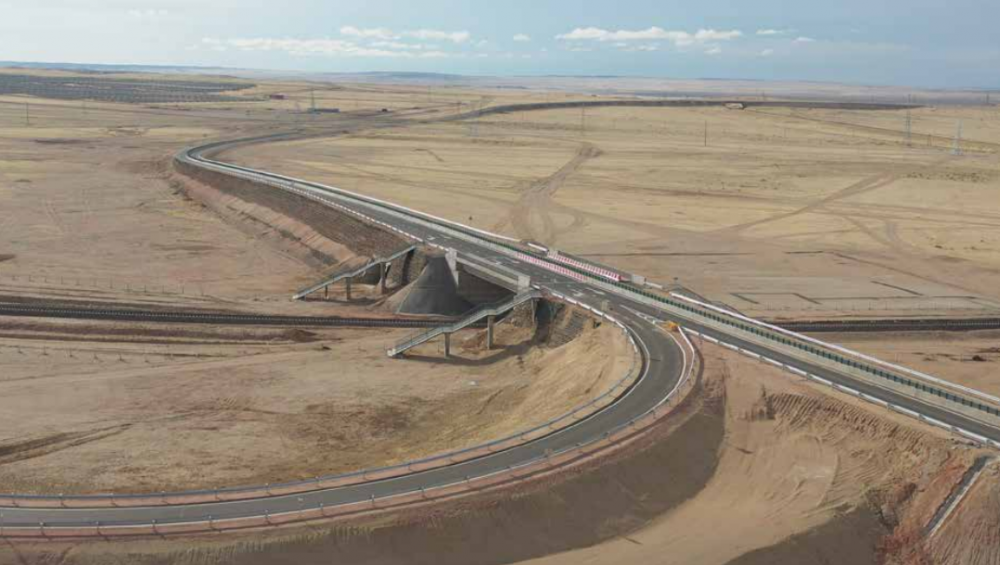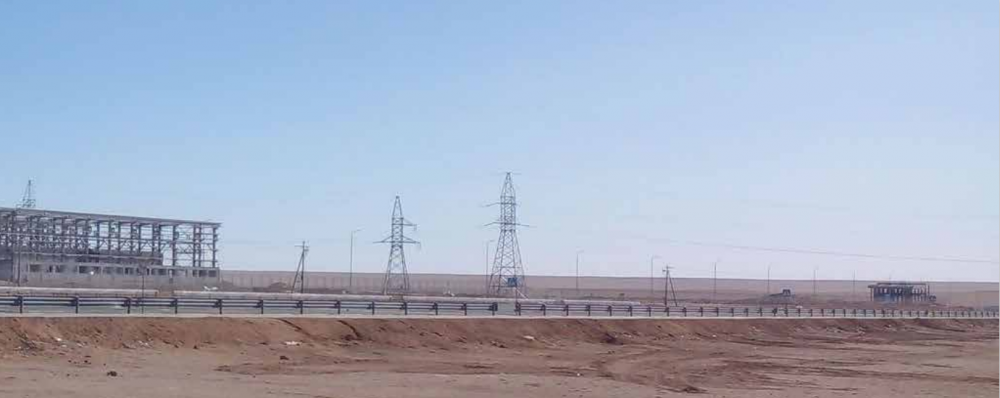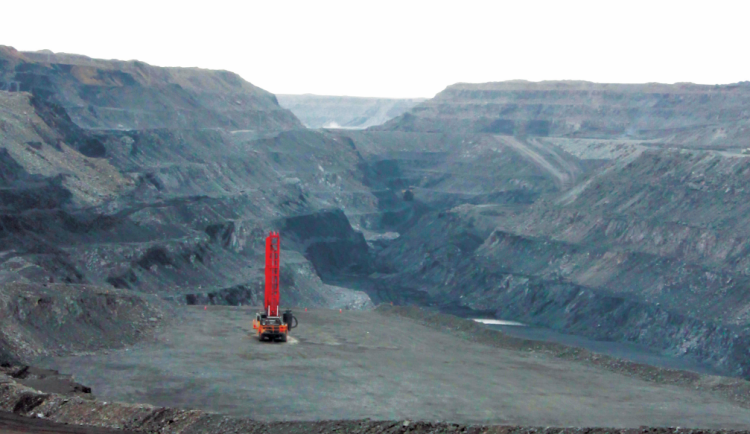misheel@mininginsight.mn
Mining Insight Magazine, March 2023
Mining Insight’s reporters visited the Altanshiree soum where the construction of the Oil Refinery is underway 17 kilometers from Sainshand soum. D. Munkhbat, a Mongolian consulting engineer and the regional representative of the Oil Refinery in Sainshand accompanied us to introduce the construction process.
Shortly after leaving the center of Sainshand, we drove along the green fenced road, passing by the powerlines and railway, and arrived at the Oil Refinery compound.
These include a 27-km long railway from Sainshand to the Oil Refinery site, a 17.5-km long heavy-duty road, and an 18.3-km long 110 kV overhead powerline in Sainshand. At the end of the road is a parking lot, and in the background, we can see the powerlines and railways that led us into the industrial area.
The equipment and industrial parts required for the construction are transported through this railway. Once the plant is operational, it will transport petroleum products such as gasoline, jet fuel, liquefied gas, and stove fuel to the capital and other cities and towns. In terms of energy, the construction is being carried out based on the 110 kV substation. As part of the EPC 3 component, a 35 MW thermal powerplant with two steam turbines will be constructed, utilizing residual fuel oil from oil distillation. The EPC 2 and 3 components are scheduled to commence in April 2023.
Upon entering the factory site, we saw sand and blocks piled up, and outside EPC 1 construction was being carried out. Due to the pandemic, the construction of the factory was suspended for two years, but the construction pace picked up again last year. During the peak work season last summer, out of 615 workers, 153 were from India. Located west of the site, the main office building of the oil refinery is visible, alongside a new laboratory currently under construction. Shaped like a ger, the two-story circular building will be used to determine the quality of oil and oil products. The oil refinery is an essential component of the petrochemical industry. It occupies a vast area of 150 hectares, which is equivalent to the size of 210 standard football fields. As part of the EPC 1 component for oil plant construction, nine civil buildings are being built, which include offices, a training center, a medical building, a fire department, a canteen, a laboratory, entrance gates 1 and 2, a warehouse, and a repair shop. In addition, infrastructural facilities such as raw water storage tanks, drains, pipelines, water storage tanks, flood catchment areas, and wells are also under construction at the industrial site.
It is estimated that the completion of work will reach 90 percent by next fall. Under the EPC 2 component or primary process and ancillary facilities, the atmospheric and vacuum distillation facilities, gas separation facilities, 42 final product storage tanks, reservoirs, rail and road loading and unloading facilities, water treatment systems, pipeline supports, and other utility facilities are detailed and included in the construction works. The construction work for EPC 2 and 3 has been contracted with "Megha Engineering & Infrastructure Limited" of the Republic of India to be completed by 2025. Under the latest EPC 4, contracts were signed with the following companies to obtain their technology licenses and patents. Kinetics Technology from Italy for hydrogen production, Honeywell UOP from the USA for gasoline processing, hydrocracking, and liquefied combustion gas separation, Shell from the UK for visbreaking, Axenx Solutions from France for sulfur plants, and diesel hydrotreating have all received patents.
The tender for this work has been announced, and participating companies have started submitting their proposals. The engineers led us to a field covered in the dirt behind the civil facility, where a massive 30,000 cubic meter water storage tank has been installed on a leveled area. As we walked around the unburied edge of the reservoir, we couldn't see the bottom of it. Engineer D.Munkhbat explained that, unlike other reservoirs in Mongolia, this one has a covered pavement, making it a significant construction feat to build 714 columns that can withstand the pressure of such a massive volume of water in an area prone to landslides.
The facility's storage tank insulation layer consists of two tanks of 15,000 cubic meters each, covered with two meters of soil. The plan is to draw water from 11 wells in Bor Khuuvur Govi, located 44 kilometers away, through a pipeline and store it. In the oil industry, water is mainly used for cooling and can be reused.
The construction of the water pipeline was completed last year, and the testing work is still ongoing To visit the oil refinery and get a glimpse of the construction work, visitors need to notify the refinery's office in Ulaanbaatar or the regional representative office at least one or two days in advance and obtain permission. However, it's not uncommon for locals on camels and horses to stop by to observe the factory.
Consulting Engineer D.Munkhbat emphasizes the importance of following the factory's rules and regulations, stating that visitors should report their visit and the purpose of their visit ahead of time. He added that while it can be difficult to gain entry to the facility, it's equally challenging to keep unannounced visitors out. When visiting the facility, it's necessary to wear personal safety equipment, which will be provided by the factory. Over five hundred people will be employed in the oil industry permanently. Therefore, a worker's town is being constructed on Janchiv Street, located on the west side of Sainshand.
The first phase of the construction consists of apartments for 40 households and is to be extended to house a total of 550 families, which will include housing, schools, kindergartens, green facilities, and recreational areas for the workers. The first phase has already been completed and put into operation, while the third and final phase is scheduled to be completed by 2024. Along with Mongolian workers, representatives of the Indian company, which is the contractor for the construction, have also moved into the first apartment.
The oil refinery requires an estimated 550 engineers and technicians. To meet this demand, the Ministry of Mining and Heavy Industry issued an order to the Mongolian University of Science and Technology to provide in-house training for 300 engineers.
The first enrollment took place last fall, and 22 students are currently enrolled, including those from the winter enlistment. In addition to training new specialists, the university will also consider enrolling graduates from the Geology and Mining School, taking into account their equivalent courses.
The "Oil Refinery Engineering" program aims to equip graduates with comprehensive knowledge of petroleum refinery operations, equipment, and processing technologies. This year, the students are scheduled to do their first internship at the Angarsk Oil and Chemical Plant in Russia. Starting next year, they will join their teachers for training at the main factory. Notably, 10 students from Dornogovi province are enrolled in the program, with one hailing from Altanshiree soum where the Oil Refinery is located. The four-stage components of the oil refinery project are progressing steadily. The first phase of work is almost complete, and the last phase has received patents, with only execution remaining. After more than 20 years of talks and planning on paper, the oil refinery is finally becoming a reality in Altanshiree soum of Dornogovi province.






















